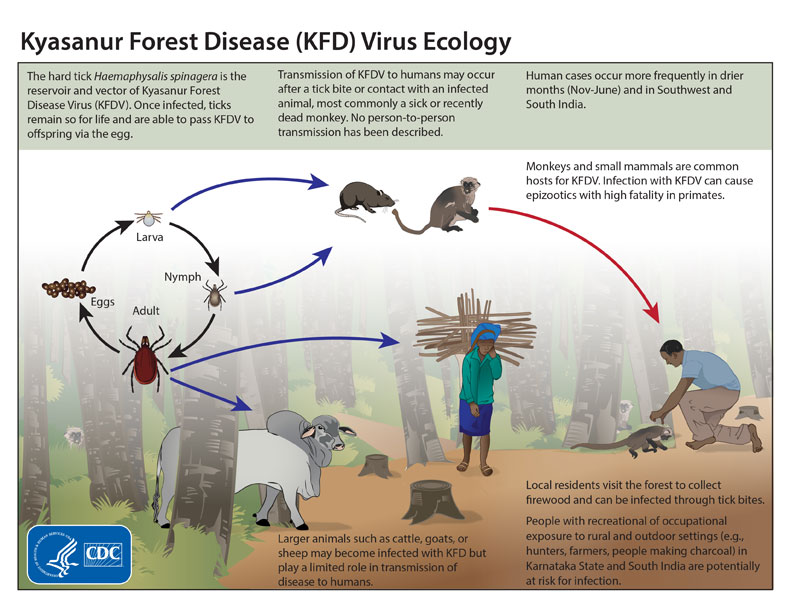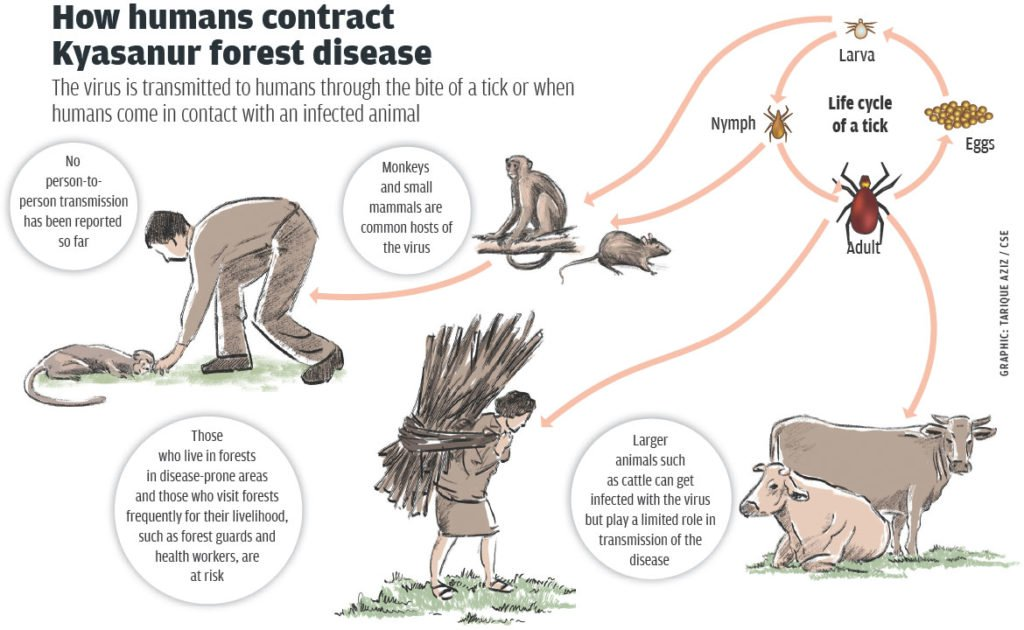Description

Copyright infringement not intended
Picture Courtesy: en.wikipedia.org
Context: A study by the Indian Council for Medical Research (ICMR) and the National Institute of Virology (NIV) has confirmed the presence of Kyasanur Forest Disease (KFD) in Karnataka
Details
- Kyasanur Forest Disease (KFD) is a tick-borne viral illness endemic to Karnataka. The disease primarily affects the Western Ghats region, including Karnataka, Maharashtra, Kerala, Tamil Nadu, and Goa.
- Morbidity is significant, with an acute and convalescent phase lasting four weeks; complications may include haemorrhage or neurological issues. Mortality rate is reported to be about 2–10%.
- Despite vaccination efforts, KFD positivity is expanding across the entire Western Ghats region. The study emphasizes the need for newer potential vaccines and the challenges in implementing control measures.
- Comparative analysis shows an insignificant difference in KFDV infection among vaccinated and unvaccinated populations

Kyasanur Forest Disease
- Kyasanur Forest Disease (KFD) is a serious and potentially fatal viral infection that affects humans and animals.
- It is caused by the Kyasanur Forest Disease Virus (KFDV), a member of the Flavivirus family that also includes dengue, yellow fever, and Zika viruses.
- KFDV was first identified in 1957 in Karnataka, after an outbreak of hemorrhagic fever among monkeys and humans in the Kyasanur Forest area. Since then, KFD has been reported in several districts of Karnataka, as well as neighbouring states of Kerala, Tamil Nadu, Goa, and Maharashtra.
How is KFD transmitted?
- KFD is mainly transmitted by the bite of infected hard ticks (Haemaphysalis spinigera), which are found in forested areas where rodents, shrews, and monkeys are common. These animals act as reservoir hosts for KFDV, meaning they can carry the virus without showing symptoms.
- Monkeys, especially the bonnet macaque and the grey langur, are also amplifying hosts, meaning they can develop high levels of the virus in their blood and infect more ticks.
- Humans can get infected by coming into contact with infected ticks or animals, either directly or through contaminated materials.
- There is no evidence of human-to-human transmission of KFD.

What are the symptoms of KFD?
- The incubation period of KFD is 3 to 8 days, meaning that symptoms usually appear within a week after exposure to the virus. The initial symptoms include High fever, Headache, Chills, Muscle pain, Vomiting, and Diarrhea.
- About 10 to 20% of patients may develop bleeding problems, such as nosebleeds, gum bleeding, blood in urine or stool, or internal bleeding. This can lead to shock, organ failure, and death. The case fatality rate of KFD is estimated to be around 2 to 10%.
- Some patients may experience a second phase of illness after a brief recovery period. This phase is characterized by neurological symptoms, such as severe headache, mental confusion, Tremors, Vision loss, and Coma.
- The neurological phase can last for several weeks or months and may result in permanent disability or death.
How is KFD diagnosed and treated?
- KFD can be diagnosed by laboratory tests that detect the presence of the virus or its antibodies in the blood or tissues of the patient. These tests include:
- Polymerase chain reaction (PCR), which amplifies and identifies the genetic material of the virus.
- Enzyme-linked immunosorbent assay (ELISA), which measures the level of antibodies against the virus.
- Virus isolation, which grows the virus in cell culture or animal models.
- There is a vaccine available for KFD that has been used in endemic areas of India since 1990. The vaccine consists of formalin-inactivated KFDV and is given in three doses at intervals of one month. A booster dose is recommended every six months for people who are at high risk of exposure. The vaccine is reported to be safe and effective in preventing KFD.
- There is no specific antiviral treatment for KFD. Patients are given supportive care, such as fluids, electrolytes, blood transfusions, and oxygen therapy. Antibiotics may be given to prevent secondary bacterial infections.
How can KFD be prevented?
- The best way to prevent KFD is to avoid exposure to infected ticks and animals.
- Wearing protective clothing, such as long sleeves, pants, boots, and hats, when visiting forested areas.
- Applying insect repellents containing DEET or permethrin on clothing and skin.
- Checking for and removing any ticks from the body after leaving forested areas.
- Avoid contact with sick or dead animals or their tissues.
- Disinfecting any tools or equipment that may have come into contact with infected animals.
- Reporting any cases of monkey deaths or illness to local health authorities.

Conclusion
- KFD is a serious and potentially fatal viral infection that affects humans and animals. It is caused by the bite of infected ticks or contact with infected animals. The disease causes fever, headache, muscle pain, bleeding problems, and neurological complications. There is no specific treatment for KFD, only supportive care. The disease can be prevented by avoiding exposure to infected ticks and animals, wearing protective clothing, applying insect repellents, and getting vaccinated.
Must Read Articles:
Kyasanur forest disease: https://www.iasgyan.in/daily-current-affairs/kyasanur-forest-disease
|
PRACTICE QUESTION
Q. Case Presentation:
A 35-year-old male presents to the rural health clinic with a sudden onset of fever, headache, and muscle pain. He reports a recent visit to a forested area in Karnataka. On examination, he has a high fever, enlarged lymph nodes, and a characteristic petechial rash. Given the patient's history and clinical presentation, the healthcare provider suspects Kyasanur Forest Disease.
Q. What is the primary vector responsible for transmitting the Kyasanur Forest Disease Virus (KFDV) to humans?
A) Aedes mosquitoes
B) Anopheles mosquitoes
C) Hard ticks (Haemaphysalis)
D) Sandflies
Answer: C
Explanation :
Kyasanur Forest Disease is primarily transmitted to humans through the bite of infected hard ticks, specifically ticks of the genus Haemaphysalis.
|













